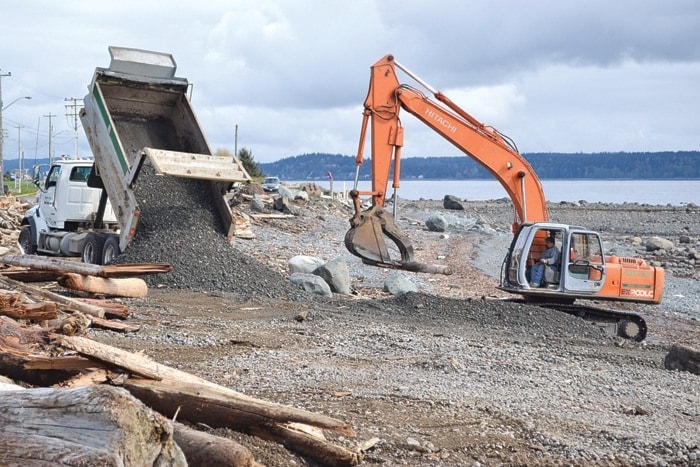A new agreement between the city and Fisheries and Ocean Canada will allow the city to clear out its two public boat ramps and improve the shoreline faster than ever before.
A memorandum of understanding between the two parties was signed two weeks ago, after more than a year of discussions to try and reach an agreement that will allow the city to remove materials that clog the boat ramps and use the debris to re-nourish parts of the foreshore.
“The (agreement) outlines a process for ongoing foreshore management that streamlines DFO’s review process and clarifies acceptable work procedures in and around the marine foreshore,” said Terri Martin, the city’s environmental coordinator, in a news release.
It was just last September that headaches with the constant build-up of rock and other debris at Ken Forde had the city considering permanently shutting down the boat ramp located across from Rona.
“If we are not able to negotiate temporary sediment storage into the MOU (memorandum of understanding), staff will be recommending that we close Ken Forde boat launch permanently. The ability to stockpile material is critical to maintaining and operating the boat ramp,” Ross Milnthorp, city manager of parks, recreationand culture, said in September 2011.
“If we are able to negotiate temporary sediment storage into the memorandum of understanding, Ken Forde boat ramp could be cleared on an as-needed basis during the recommended annual opening period.”
The new agreement means the city will be able to maintain both Ken Forde and Big Rock boat ramps from May through September each year and the city will be allowed to draw up a preliminary schedule dictating where material from both Ken Forde and Big Rock will be going each year.
“The memorandum of understanding is built on including a list of sites (along the foreshore) that we’re going to restore and when and where we’re going to do that,” Milnthorp said last year. “Essentially, it’s really all about protecting the foreshore.”
The agreement applies to projects that restore natural beach slope to allow natural movement of wood and gravel and to protect the shoreline and foreshore as well as nearby roads, sewer and water lines, and the seawalk from erosion during storms and flooding.
In the past the city has used debris from the boat ramps to restore badly-eroded areas at Rotary Beach, Dick Murphy Park (formerly the spit), and other areas along the Island Highway such as Ellis Park.
The agreement is based on the city’s Marine Foreshore Habitat Assessment and Restoration Plan, complies with the Federal Fisheries Act and is expected to shorten the Fisheries and Oceans review process time from months to 10 business days.
“With this agreement, Campbell River has demonstrated how seriously it takes its obligation to restore degraded and eroded foreshore areas,” Milnthorp said. “The city’s Marine Foreshore Habitat Assessment and Restoration Plan is an innovative long-term foreshore management strategy. This approach is particularly essential in view of anticipated rise in sea/tidal levels linked to climate change, and this agreement sets an example for other coastal communities to follow.”
The city’s efforts have already garnered provincial attention.
Soft-shore restoration work at Dick Murphy Park received a gold level rating from the Green Shores Technical Working Group, a project of the Stewardship Centre for BC.
Hard shore foreshore treatments such as rip rap and sea walls remain outside the scope of this new agreement.
